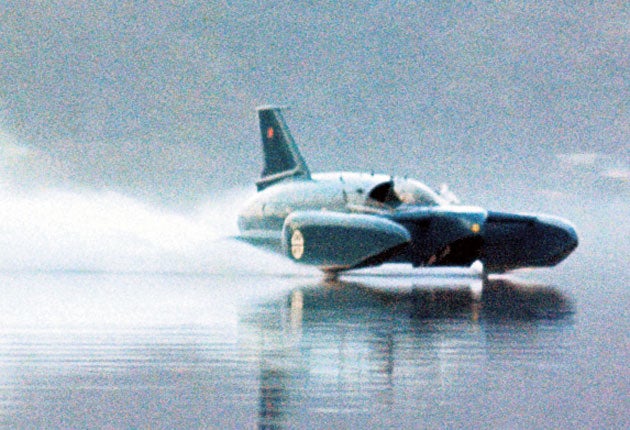42 years after Campbell's fateful run, Bluebird returns to Coniston Water
Daughter celebrates vote to allow 100mph speed trial on lake where father died

Your support helps us to tell the story
From reproductive rights to climate change to Big Tech, The Independent is on the ground when the story is developing. Whether it's investigating the financials of Elon Musk's pro-Trump PAC or producing our latest documentary, 'The A Word', which shines a light on the American women fighting for reproductive rights, we know how important it is to parse out the facts from the messaging.
At such a critical moment in US history, we need reporters on the ground. Your donation allows us to keep sending journalists to speak to both sides of the story.
The Independent is trusted by Americans across the entire political spectrum. And unlike many other quality news outlets, we choose not to lock Americans out of our reporting and analysis with paywalls. We believe quality journalism should be available to everyone, paid for by those who can afford it.
Your support makes all the difference.Forty-two years after the spectacular accident which killed its driver Donald Campbell, the jet-powered Bluebird could return to the waters of the Lake District.
Volunteers who recovered the wreck from the depths of Coniston Water and painstakingly restored it have been given permission for one-off 100mph speed trials on the lake where Campbell died.
Members of the Lake District National Park Authority, meeting in Kendall, Cumbria, agreed yesterday to allow a speed test to assess the restored vessel's performance ahead of possible further outings.
The decision, which must be submitted for government approval, amended a hard-fought-for bylaw banning power vessels from exceeding 10mph on the lake. Boats can exceed the limit if they are trying to set a world speed record but Bluebird will only be primed to reach 100mph.
Bill Smith led the five-year search to recover Bluebird, pulled from the depths in 2001. "I am euphoric at the prospect of having the final objective in sight," he said. "We now need to prove that it works and is in the condition that it was just before the crash.
"This means so much to me personally because I started looking for the wreck in 1996 and to my mind it is obvious that Coniston is the right place to attempt to get it back in the water."
Campbell was a giant of motorsport, breaking eight world speed records in the 1950s and 60s and becoming the only person to hold both the land and water records in the same year. His father Sir Malcolm Campbell held 13 speed records in the 1920s and 30s. But Campbell died in 1967 aged 45 when he attempted to break his own world water speed record of 276.3mph, set three years earlier in Australia. Having fitted Bluebird with a Bristol Orpheus jet engine, he was beset by a series of glitches during trials. On the day of his death he achieved speeds in excess of 320mph before somersaulting and cartwheeling across the heavy swell, snapping the boat in half. Campbell was killed instantly in the crash.
His daughter, Gina Campbell, was said to be thrilled by yesterday's decision. "She wants to see her father's memory brought to the fore," said Mr Smith. "She sees this as a fitting memorial."
Only four members of the 15-strong authority voted against amending the bylaw. Ninety per cent of the public who responded to a questionnaire backed the change. But there must still be a formal consultation and possibly a public inquiry. Speaking against the proposal, Peter Phizacklea asked the meeting: "What is so important about the testing of Bluebird that we should be actively contemplating changing our own bylaw?"
The current world water speed record of 317.6mph was set by Ken Warby in Australia in October 1978.
Join our commenting forum
Join thought-provoking conversations, follow other Independent readers and see their replies
Comments